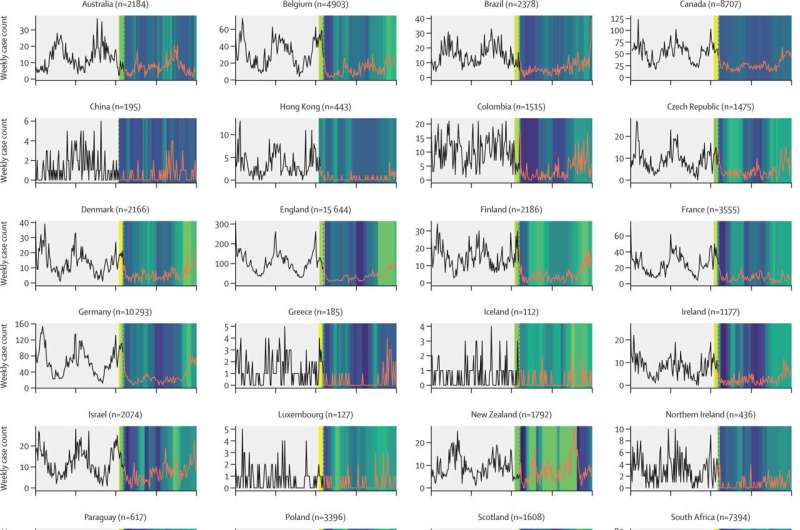Infection
COVID-19 measures found to also reduce life-threatening invasive bacterial infections
Containment measures introduced to prevent the spread of SARS-CoV-2 resulted in a sustained reduction in the transmission of certain bacteria that cause diseases such as meningitis, sepsis and pneumonia, according to a new study published in The Lancet Digital Health by the Invasive Respiratory Infection Surveillance (IRIS) Consortium.
The study analyzed the incidence of invasive bacterial disease caused by Streptococcus pneumoniae, Haemophilus influenzae, Neisseria meningitidis and Streptococcus agalactiae two years before (2018–2019) and during (2020–2021) the pandemic.
The researchers analyzed disease cases by patient age and serotype or serogroup (variants within species of bacteria that are related to the severity of disease and are the target for vaccine-mediated protection) to assess changes that may have implications for management of the diseases and vaccination programs.
The stringency of each country’s COVID-19 containment measures was quantified using the Oxford Blavatnik COVID-19 Government Response Tracker. This stringency index combined nine indicators that were tracked daily: school, workplace, and public transport closures; public event cancelations; gathering restrictions; stay at home requirements; internal movement restrictions; international travel controls; and public information campaigns.
Overall, 116,842 cases of invasive disease were analyzed in this study: 76,481 pre-pandemic (2018-2019) and 40,360 during the pandemic (2020-2021). Key findings include:
- The number of S. pneumoniae, H. influenzae, and N. meningitidis cases during 2020–21 was approximately half the expected number each year compared to pre-pandemic totals;
- During the pandemic there was a significantly reduced risk of invasive disease caused by S. pneumoniae (relative risk: 0.47; 95% CI: 0.40–0.55), H. influenzae (0.51; 0.40–0.66) and N. meningitidis (0.26; 0.21–0.31). There was no significant change in the risk of invasive disease caused by S. agalactiae (1.02; 0.75–1.40);
- There were no major changes in the overall patterns of disease by patient age or bacterial serotype/serogroup;
- Invasive disease cases began to increase in some countries as pandemic restrictions were lifted;
- Over 36,000 estimated cases of invasive bacterial disease were averted during the first two years of the pandemic in the 30 countries participating in this study.
Dr. David Shaw, lead author and DPhil student at Oxford Population Health, said “Our study demonstrates the substantial impact that COVID-19 containment measures had on reducing the transmission of bacterial organisms spread via respiratory droplets. Despite effective vaccines and therapies being available, these organisms pose significant public health challenges and account for a substantial burden of disease globally.”
“The IRIS Consortium includes 30 countries with a range of income levels, and thus provides a unique and unprecedented opportunity to understand the effects of pandemic-imposed containment measures, compare these effects between regions, and track changes in disease incidence and distribution in real time. The international collaboration across national reference laboratories with high population coverage is a significant strength of our study, providing a large, robust and reliable dataset for analysis.”
“As the IRIS Consortium matures, we will be able to address important questions beyond those related to the pandemic and our findings will hopefully contribute to improved diagnostic, preventative and therapeutic approaches in the future.”
Angela Brueggemann, Professor of Infectious Disease Epidemiology at Oxford Population Health, Director of the Infectious Disease Epidemiology Unit and senior author of the paper, added “It is expected that the rates of invasive bacterial disease will increase post-pandemic and the key question going forward is which types (in particular which serotypes/serogroups and genetic lineages) of bacteria will cause disease. The bacterial populations have been disrupted by the pandemic and that might lead to different patterns of bacterial disease in the future.”
“Certain populations such as children and older adults are inherently at greater risk of invasive infections caused by these bacteria, but safe and effective vaccines to protect against S. pneumoniae, H. influenzae and N. meningitidis disease are already in use in many countries worldwide. Any disruptions to these bacterial vaccination programs must be resolved as a matter of urgency, in order to protect the most vulnerable in our populations.”
“These IRIS data improve the understanding of transmission dynamics, can be used to inform vaccine programs, and contribute to the planning of health care services and policy design.”
The Consortium previously reported on significant reductions in the incidence of diseases caused by Streptococcus pneumoniae, Haemophilus influenzae, and Neisseria meningitidis (all of which are transmitted person-to-person through respiratory droplets) early in the pandemic, and demonstrated that these reductions were associated with the timing and stringency of pandemic containment measures.
Streptococcus agalactiae (group B streptococci, not transmitted via the respiratory route) was also included to assess whether routine disease surveillance was affected by the pandemic; there were no significant changes in reported cases of S. agalactiae showing that accurate comparison of data from before and during the pandemic could be made.
More information:
David Shaw et al, Trends in invasive bacterial diseases during the first 2 years of the COVID-19 pandemic: analyses of prospective surveillance data from 30 countries and territories in the IRIS Consortium, The Lancet Digital Health (2023). DOI: 10.1016/S2589-7500(23)00108-5
University of Oxford
Citation:
COVID-19 measures found to also reduce life-threatening invasive bacterial infections (2023, July 28)
retrieved 28 July 2023
from https://medicalxpress.com/news/2023-07-covid-life-threatening-invasive-bacterial-infections.html
This document is subject to copyright. Apart from any fair dealing for the purpose of private study or research, no
part may be reproduced without the written permission. The content is provided for information purposes only.

